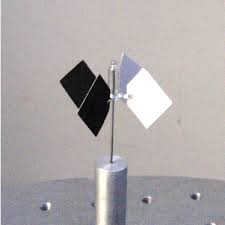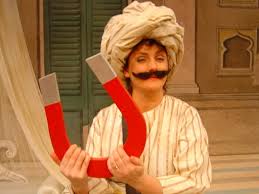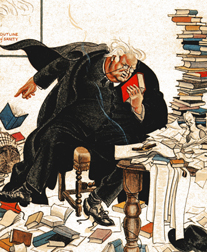scientists: gilbert coulomb poisson maxwell lodge crookes mesmer
 Sunday, July 6, 2008 at 10:13AM
Sunday, July 6, 2008 at 10:13AM  Another image of pure Gemini from Saul Steinberg (June 15, 1914).
Another image of pure Gemini from Saul Steinberg (June 15, 1914).
Scientists usually feel left out when the topic of astrology arises; they should not. For instance, a clearly disproportionate number of the seminal names in the physics of magnetism were born under the Twins, the primal dualism, Gemini:
William Gilbert, author of De Magnete, ("the first great English scientific work") was born May 24, 1544. He discovered that the Earth is a giant magnet.
Charles Augustin de Coulomb (born June 14, 1736). In seven papers on electricity and magnetism published between 1785 and 1789, he explained the mathematical laws of attraction and repulsion between magnetic poles and electric charges.
Simeon Poisson, mathematician (b. 21 June 1781) " . . his memoirs on the theory of electricity and magnetism, virtually created a new branch of mathematical physics. ..... made important contributions to the theory of attraction."
James Clerk Maxwell (b. June 13, 1831), author of the 1873 Treatise on Electricity and Magnetism demonstrating the identity of the two phenomena, "the most important physicist between Newton and Einstein".
These four men established the theory that the material world is essentially constituted by the interplay of two opposing immaterial forces. Equally entranced by the dance of plus and minus was the genius British technoscientist Oliver Lodge (b. 12 June 1851). He extended and applied electromagnetic theory to wireless transmission, the bipolar electrical cell, the study of lightning, automotive engineering (the spark plug), and fog-busting. He might almost be the man in Steinberg's drawing. Oliver Lodge was also twice a highly active president of the British Society for Psychical Research.
Another important scientist and British SPR president was Gemini Sir William Crookes (17 June 1832) who made discoveries in many scientific realms, including electricity. He is best remembered for the Crookes radiometer, which moves by virtue of the difference between black and white.
June 1832) who made discoveries in many scientific realms, including electricity. He is best remembered for the Crookes radiometer, which moves by virtue of the difference between black and white.  Gemini Wallis Simpson's witty earrings
Gemini Wallis Simpson's witty earrings
 Mention must also be made of another experimenter associated with a form of magnetism, so-called animal magnetism: Franz Anton Mesmer (b. May 23, 1734) who, applying the principal of universal immaterial polarized force to medicine, psychology and sexuality, was the progenitor of dynamic psychiatry and the experimental approach to subjectivity. Mesmerism was, of course, a principle object of study at the SPR.
Mention must also be made of another experimenter associated with a form of magnetism, so-called animal magnetism: Franz Anton Mesmer (b. May 23, 1734) who, applying the principal of universal immaterial polarized force to medicine, psychology and sexuality, was the progenitor of dynamic psychiatry and the experimental approach to subjectivity. Mesmerism was, of course, a principle object of study at the SPR.
At the time of the flourishing of the SPR London was awash with Gemini writers characteristically eager to extend communication. Arthur Conan Doyle (22 May 1859) and G. K. Chesterton (29 May 1874), both alter-egos of popular psychic investigators (Sherlock Holmes and Father Brown) both also deeply pursued mediumistic contact with their departed, beloved brothers. The poet W. B. Yeats (13 June 1865) while working with Crookes on a spirit-voice transmission device, runs into novelist Arnold Bennett (27 May 1867) at a seance . . . Gemini embraces any possibility of communication. No wonder Timothy Berners-Lee, inventor of the internet, is a Gemini.
This universe a thing of dream
substance naught & Keystone void
vibrations of symmetry Yes No
Foundations of Gold Element Atom
all the way down to the first Wave
making opposite Nothing a mirror
which begat a wave of Ladies marrying
waves of Gentlemen till I was born in 1926
in Newark, New Jersey under the sign
sweet Gemini ---
ALLEN GINSBURG

